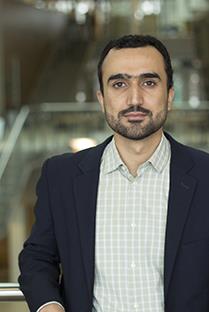
By Veronica E. Tremblay, 2019
“I decided to come to KAUST for a postdoctoral fellowship because I recognized the quality work being done.”
While finishing his PhD and first postdoc at the Ruhr-University of Bochum in Germany, Dr. Anas Chaaban often scanned the monthly IEEE Communications Society Publications Contents Digest to stay current on new work published on communications technologies. He noticed that publications from KAUST were mentioned in every issue. He was impressed by the quality and quantity of research coming out of a young university founded only in 2009. Also, KAUST’s active participation in international conferences had already created a strong brand with global recognition. After meeting with KAUST researchers at several events, Chaaban decided to join the KAUST Communication Theory Lab in 2015.
“Great opportunity to connect theory to practice.”
Under the mentorship of his postdoctoral advisor, Professor Mohamed-Slim Alouini, Chaaban worked on the topic of free-space optical communications (FSO). FSO allows high-speed wireless transmission of data between two nodes, the transmitter (either a modulated laser or LED) and the receiver (some optical detector), through air or space. One key advantage of FSO is that physical connecting fibers, such as the fiber-optic cables that make up the “backbone” of the Internet, are unnecessary. Radio-frequency communications are also wireless, but they suffer from spectrum shortage. FSO channels provide additional spectrum with minimal infrastructure. For this reason, space agencies use FSO for communications among spacecraft, satellites and ground stations. More down-to-Earth applications include LAN connections within offices and temporary installations for events.
For obvious reasons, optical wireless communications that depend on line-of-sight between two lasers can be difficult to maintain under murky or polluted atmospheric conditions. Multiple FSO channels, such as several lasers with several light detectors, may be used in parallel to maintain satisfactory data transmission. However, the capacity of an FSO channel – the maximum data rate in bits per second that a channel can support – is difficult to calculate directly. Optimizing these bounds across the FSO channels in a communications system is necessary to enhance the network performance.
At KAUST, Chaaban worked to find new methods of deriving FSO channels’ upper and lower bounds to better approximate their true capacity. By obtaining the capacity bounds, Chaaban could predict the probability of a network outage under various conditions.
In collaboration with KAUST Professor Boon Ooi’s Photonics Laboratory, Chaaban also applied communication theory to both open air and underwater optical communications by providing the digital communications expertise for proof-of-concept experiments.
“KAUST is an excellent opportunity that will give you a big kick forward, and you should make use of its many resources and facilities to soar in your careers.”
KAUST is a small science city that is both academically and culturally diverse. With no commute and free accommodation, KAUST postdocs are free from many of the daily pressures that distract them from their research elsewhere. While at KAUST, Chaaban could devote his full attention to research and the professional development that would propel him forward in his academic career.
Chaaban participated in multiple collaborations, networked at international conferences, enjoyed membership in relevant research societies, co-wrote a successful CRG proposal based on a collaboration with Princeton and the University of Idaho, and gained experience mentoring the exceptional students of his research group. Still, he found time to unwind with his colleagues on the occasional Red Sea fishing trip, where they might spot a spiky-finned grouper or brilliant blue parrotfish.
Dr. Anas Chaaban is an assistant professor at the University of British Columbia, Okanagan Campus, where he leads the Communication Theory Lab and teaches classes in electrical engineering. His research topics include network information theory, as well as the theory and practice of optical wireless communications. He was a postdoc in Professor Mohamed-Slim Alouini’s Communication Theory Lab at KAUST from 2015 to 2017. He now collaborates with Alouini’s research group as co-PI on a new CRG project titled “Topological Optimization of Dense Cellular Networks Based on Novel Interference Management Techniques.”
Selected publications:
1. X. Sun, W. Cai, O. Alkhazragi, E. Ooi, H. He, A. Chaaban, C. Shen, H. Oubei, M. Khan, T. Ng, M. Alouini, and B. Ooi, "375-nm ultraviolet-laser based non-line-of-sight underwater optical communication," Opt. Express 26, 12870-12877 (2018).
2. X. Sun, Z. Zhang, A. Chaaban, T. Ng, C. Shen, R. Chen, J. Yan, H. Sun, X. Li, J. Wang, J. Li, M. Alouini, and B. Ooi, "71-Mbit/s ultraviolet-B LED communication link based on 8-QAM-OFDM modulation," Opt. Express 25, 23267-23274 (2017).
3. A. Chaaban, J. Morvan and M. Alouini, "Free-Space Optical Communications: Capacity Bounds, Approximations, and a New Sphere-Packing Perspective," in IEEE Transactions on Communications, vol. 64, no. 3, pp. 1176-1191, March 2016. doi: 10.1109/TCOMM.2016.2524569